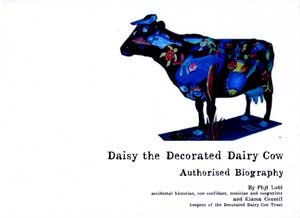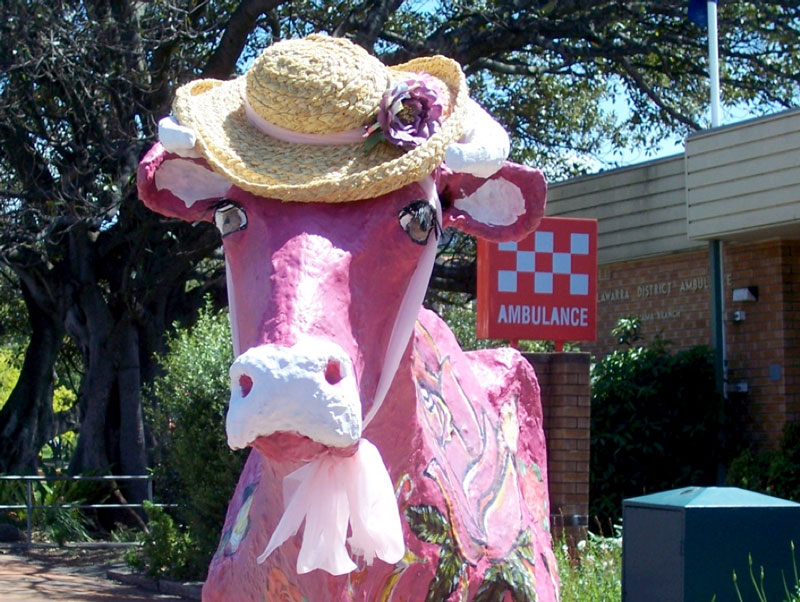ARTICLES
Background to Daisy the Decorated Dairy Cow
The story of how such a project came about can be told.
Daisy is a full scale model cow used to advertise the Arts outside of the Old Fire Station in Kiama, a coastal town in southern New South Wales, Australia.
Daisy, the Decorated Dairy Cow aroused my curiosity when I was invited to participate in a writing project run by Rae Luckie located at the Kiama Library. It was called "Memories Of Kiama". I had been living in Kiama for a few years so I felt a little short on suitable Kiama memories, however it was suggested we look around the town and some idea for inquiry might occur to us.

I wandered by the Old Fire Station and as a consequence looked into Daisy’s eyes. For a wire, paper, and plaster model her eyes seem uncannily organic and compelling.
My wandering led to wondering.
Wondering when Daisy began.
Wondering who had made her.
Wondering how many times she had been painted and if there was a record of photographs of the Daisy paintings.
There wasn’t.
In Louise Croker’s (Kiama Council Arts Officer) words I became an “accidental historian”. With her help the book happened.
My interest sparked by the cow may have come about as a result of genetic inheritance and early environmental factors. Let me explain my cow credentials.
My Mum always had a house cow, even when we moved from farms to the edge of a town in Victoria. There were many possible reasons for this.
- She had grown up on a farm and liked cows.
- She liked having a fresh milk supply.
- Having a cow gave her a sense of security.
This last may have come about because during the depression, when Dad had no job, the “Bank People” came looking for what they could get out of an impoverished family. They took the only thing of any worth, the House Cow. I expect the incident was a trauma for my Mum and perhaps having a cow went some way to alleviating the feeling of loss felt at that time.
As a teenager I once had to help her take a cow to the market before school. The market was adjacent to the school football field. Before school it was peopled by the boys from my senior class. My “Self-conscious Prefect Self ‘ felt embarrassed beyond belief. Embarrassed that my Mum was wearing a stripy butcher’s apron she had found on the road and on her head wore my Dad’s slouch hat. Above all I felt ashamed of the cow.
Daisy brought it all back. I regretted my teenage shame and maybe subconsciously decided to honour this one cow, cow culture and my Mum all at the same time. I also used to help on a dairy farm when I first went teaching in Gippsland and along with a few other other cow experiences when on a songwriting project in Tasmania I can say that in time I became comfortable with cows.
These are my cow credentials.
Those I first asked about Daisy’s history seemed vague at best and totally devoid of knowledge at worst, so I went digging. I found that Kiama had a tradition of painting life-sized cows.
Some stories of a policeman’s real cow being painted white were circulating back beyond the cow made by Daphne Wilson in 1957. That full-sized model was made to represent the dairy industry at springtime festivals and was called Lemon Grove Margaret the 6th.
Daisy appeared in 1991. Her full regal name is Meadowhaven Daisy the 47th. Made by sculptor Ernesto Murgo for a Community Arts project for the Seaside Festivals at the urging of the then Kiama Coucil Arts Officer Grahame Kime.
And so began the phenomenon of Daisy the Decorated dairy Cow in Kiama.
I can’t help but wonder if the now world wide Cow Painting phenomenon began with Daisy.
Unlike most of the world wide cows, which are painted usually only once, Daisy is
repainted frequently throughout the year. Between ten and twenty times. She is a
Community Art enterprise. This means that in the almost twenty years she will have been painted close to 200 times.The world cows are painted often by established artists and then sold. The Picasso Cows now painted to highlight Dairy Industries in many places are painted most often by schools. Daisy is different. She also creates controversy. She has had a few adventures in her time. In the book some of those adventures and the controversies she creates are related.
I asked fifty citizens about their reactions to Daisy and their remembrances.
I asked those in closer contact, councillors, artists, relations of the artists involved.
The comments were surprising. Some people never noticed. Mostly they belonged to the group of people who have trouble locating butter in a fridge or sox in a drawer. I say no more. Dogs notice though and most bark only if she is painted black and white.
A result of all this asking became a photo search.
The result of the photo search are in the book.
I learnt much about the breed that developed in the Kiama area. The Australian Illawarra Shorthorn or AIS. They are described as being: “A deep roan colour and with a capacious milk vessel.” In human terms this makes AIS cows a cross between Rita Hayworth and Dolly Parton.
A Dairy Industry Handbook stated the necessity for a “sharp clean outline without any sign of beefiness”. It made me wonder if at times when she had been painted in various “costumes” Daisy would have liked to be able to say,
Does my bum look big in this?
I also went on a search of other folklore associated with cows.
here are some reminders of how bovine folklore is projected into our language:
When we are born someone might say:
Looks as though butter wouldn’t melt in the mouth.
Those siblings are as alike as chalk & cheese.
At school we can get called butterfingers or told not to,
cry over spilt milk not to be a cowardy custard and we gaze in wonder at milky way.
We grow up into the world and learn to that some people
butter someone up, milk something for all its worth, and cream things off.
In our working world:
we have a cow of a day, get cheesed off, often at the big cheese who is the cream of the crop and who takes junket trips, often is a silly cow, full of bull shit who has been known to give or cause us to give a blood curdling yell.
I also collected this “Cow Definition”:
Four stiff standers, four Dillydanders,
Two hookers, two lookers, and a flip about.
Source: Harry Slip
Daisy to me is an appropriate symbol of the town of Kiama linking its past, its ethos and its future. Her coats of many colours reflect the care and compassion demonstrated by the activities of its many organisations, the sense of community, the creativity and the comedy that are revealed when you take the time to explore this coastal town of many colours. She is truly a Community Cow, truly an art-force, more than the sum of her parts or her past, she is a presence.
She occasionally whinges or is a bit picky.
But mostly she is an optimist. As she says:
Maybe I did start something.
Maybe someone will find out for sure.
Maybe more photos will come home.
Maybe they can be used to help the town.
I know I’m not on my last legs yet.
I know I’m not the only one thinking of possibilities..
I know I have friends in elevated places in this town.
After all I am Meadowhaven Daisy the 47th.

